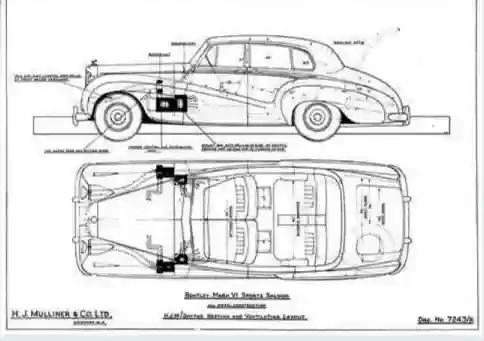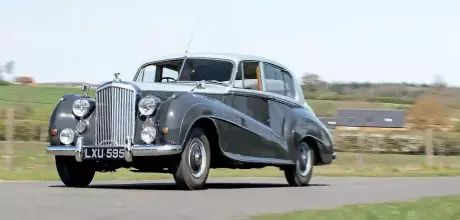1951 Bentley MkVI ‘Lightweight’ by H.J. Mulliner
Some of the most popular coachbuilt bodies on the Bentley MkVI chassis were the advanced ‘Lightweight’ saloons by H.J. Mulliner. While their lightness may only have been relative, their individuality and character was never in doubt. Today, they’re something of a bargain, too.
WORDS NIGEL BOOTHMAN
PHOTOS: GREGORY OWAIN
LIGHTNESS OF TOUCHMK VI LIGHTWEIGHT COACHBUILT CHARACTER
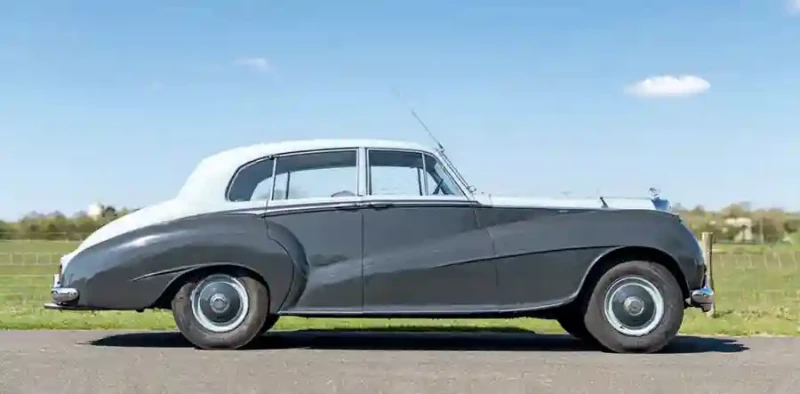
Say hello to LXU 595, also known as chassis B193HP, a Bentley Mk VI bodied to ‘Lightweight’ saloon design 7243 by H.J. Mulliner and delivered to Brooklands of Bond Street in February 1951. Here it acquired its London registration; the LXU series was introduced the same month the car was delivered. The first owner was due to be HW Carrington of Carrington & Dewhurst Ltd, a successful Lancashire-based manufacturer of woven rayon fabric. But poor Mr Carrington expired before he could take delivery and the car seems to have passed to another industrial concern, Bomford Pollard Ltd, apparently a subsidiary of Carrington’s.
It’s fun to imagine our car transporting forthright northern industrialists and their clients between the company’s various sites in Rochdale, Bradford and elsewhere, but it’s also intriguing to consider why they chose it in the first place. After all, the Standard Steel saloons were fine cars with an established image by 1951, and they were not inexpensive – nearly £3000 at launch in 1946 and just over £4000 by the time the R-type took over in 1952. That equates to eight new Austin A30s, three Jaguar Mk VIIs or two Daimler Regencys. Yet even the most keenly-priced coachbuilt saloon Bentley was at least a third as much again as the Standard Steel offering.

Looking at the options from a present-day point of view makes it seem strange that anyone would pay so much more for a slightly different external appearance with no real changes to internal accommodation or luxury, performance, ride and handling, economy or any of the other factors we’re supposed to consider when choosing a car. So we need to see things as the affluent buyers of the early 1950s would have done. These people had spent their adult lives in an era when the best cars had coachbuilt bodies, usually with no option for a standardised factory body. Such customers were often traditionalists and would be as familiar with tailor-made suits and boots as they were with coachbuilt cars. It was, in other words, entirely normal to choose your favoured highquality British marque and then place an order with a coachbuilder for the shape that appealed most to you. Yes, it cost more than the Standard Steel option, but one suspects most of the people who bought coachbuilt Mk VI Bentleys didn’t consider anything else.
ABUNDANT OPTIONS
Our ‘Lightweight’, design 7243, was a popular choice. H.J. Mulliner clothed more Mk VI chassis than any other coachbuilder, though if you’re not a Mk VI afficionado many of them require a second look to mark the differences from the Standard Steel model. Their best-seller, design 7059/C and the very similar 7122 accounted for 125 and 36 examples respectively, adding longer front wings and a rear quarterlight to the standard form, but not a lot more besides. Design 7220 was another strong-selling shape (64 were made), a more rakish form with a higher, longer tail. Our design, 7243, appeared on 41 Mk VI chassis and looked a generation younger than the alternatives, including the Standard Steel saloon.

No surprise, then, that it lasted through R-type production as well, with another 34 examples produced. In the flesh, it’s perhaps a taller, more formal car than it appears in these photos. From the side, you could be forgiven for thinking it’s a late 1950s contemporary of the S-series saloon, but walk around the front and it’s as though the high, rather narrow-looking nose seems to alter the proportions.
The two-tone paint (not always a feature of this example, which has been all one colour at times in its past) lifts it nicely, helping to separate the airy glasshouse from the car’s deep flanks. Those little swages rolling back from the top of each wheel arch are a good touch too – just like the speed lines some of us applied to a doodle of a fast car when we should have been paying attention at school. But why ‘Lightweight’?
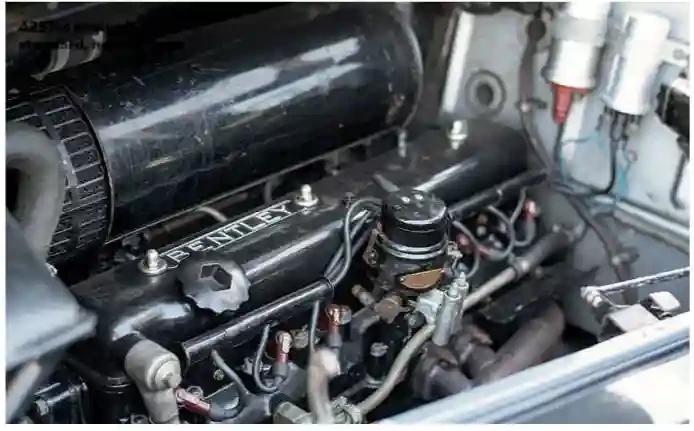
Surely most coachbuilt bodies used aluminium panelling rather than steel, so what makes this one special? The difference here is in what lies beneath the panelling. H.J. Mulliner had achieved success before the war with a fine three-way blend of beautiful styling, high craftsmanship and technical innovation. The last of these three manifested itself when peace came in an ambition to move away from traditional wood-framed bodies to something less labour intensive, lighter and more durable.
They found an excellent way to achieve this, as detailed in the box-out above. H.J. Mulliner built both the R-type Continental prototype, ‘Olga’, and production models using this method of construction, which entered production in 1952. Before that, they also employed the technique for design 7243; the car in our pictures was the fifth example built. We haven’t found a record of the kerb weight for a Mk VI with this body, but we can make an educated guess.
A Standard Steel saloon in 4.-litre form is 37cwt (4144lb or 1884kg) with five gallons of fuel aboard. The R-Type Continental was built to a target weight of 34cwt (3808lb or 1727kg). Our car can’t be quite that svelte, thanks to the extra pair of doors, but then again, the 4.0-litre R-Type started around 25kg heavier than the small-bore Mk VI, so perhaps we can hope for a 100kg saving over the Standard Steel saloon. It's not transformative, but it’s handy.

After all, Rolls-Royce were obliged to increase the capacity of their inlet-over-exhaust straight-six from 4257cc to 4566cc and then 4887cc as coachwork grew and expectations increased, just as the Derby Bentley 4. and Rolls-Royce 25/30 needed their extra capacity in the 1930s. So trimming the weight of a passenger and his luggage off a saloon was not to be sniffed at, especially if the bodywork would prove more durable.
Here, we’re in subjective territory without using tables of survivorship to compare between different coachbuilt models, but it feels as though a lot of these 7243 saloons have survived, doesn’t it? There are always one or two for sale and they seem at least as familiar as the more numerous Mulliner four-door six-light saloons with their ash-framed construction.
FEELING THE BENEFIT
If there’s one place the advantage of this weight loss should be felt, it’s behind the wheel. This car is mechanically very fit, having only covered a few hundred miles since a huge spend seven or eight years ago, covering various aspects. So it idles well and generally feels very smooth, though that limited usage reveals itself in a slight stiffness that’s apparent in a few of the controls, and the way it moves over poorer surfaces. But it’s ever so comfortable, with lots of fore and aft adjustment in the broad, accommodating seats, which have the nice feature of an armrest in each side rather than relying on a door-mounted rest.
The handbrake is less awkward than most under-dash umbrella handbrakes and it releases easily, so away we go. The gearbox and clutch are lovely, bar a tiny bit of judder on take-up, and here the car’s relative drop in mass from a steel-bodied model is instantly apparent, and perhaps helped by the lowish gearing. It’s easy to forget that cars of this age were created before we had any motorway at all, and relaxed cruising at 70mph wasn’t expected to be the norm. As a result, it starts to feel quite busy at 55mph and beyond, but that’s mainly because there’s so little awareness of engine and driveline at lower speeds. Doubtless it would steam up the M6 to its old haunts in the industrial north at the speed limit without complaint. Around here, near Vintage & Prestige’s Northampton premises, third is a useful go-anywhere gear that covers walking-speed crawls in traffic right up to a surge of acceleration onto a dual carriageway.

Simone Della Corte, V&P’s showroom manager, had been using the car as his runabout in the days before we arrived for the photoshoot, and it’s easy to see why. The car’s condition – smart and sound without being the kind of concours candidate you’d fret about, combined with the comfortable, airy cabin and easy controls make it a charming option…even in a showroom full of far more glamorous and costly vehicles. The clap-hands format of the doors makes for better access to the rear seats than in a steel saloon, where the rather narrow door reveals an armrest you need to swerve on your way in. Here, there’s even a capacious boot; perhaps a need to carry visitors' luggage was another reason this body was chosen by its first owners.
A final dip into the hefty history folder reveals that this car passed from Bomford Pollard to the Yorkshire Engineering & Welding Co Ltd in 1961, following an engine overhaul at 41,000 miles. It then moved on to its first private owner, Stanley North, a bandleader in Bradford, who used it until 1975 before it spent a period off the road. In use again from 1981, it changed hands after North died in 1988, eventually settling between 1990 and 2004 with Godfrey King, then technical adviser to the RREC on post-war Bentleys. Adventures since then include some time in Sweden, when it enjoyed the heftiest ‘D’ service you’re likely to encounter, costing SEK 330,000 (more than £30,000) and including a tow-bar devised by renowned model expert Norman Geeson – now removed.

Bentley Mk VI saloons came in all sorts of shapes and have enjoyed all sorts of histories, but they have one thing in common – they tend to endure. This one, probably thanks to its forward-thinking Mulliner construction, has endured better than many despite a busy early life as a company car and a long, active history as a cherished classic. It’s been fascinating to see what the extra £1000 or so over the ‘normal’ Mk VI saloon would buy in 1951, and rather tempting to note that such cars are no longer separated by the 35% price hike they represented when new.
THANKS TO: Vintage & Prestige, vandp.net, 07967 260673, Tom Clarke, Will Morrison, Marcus Dean
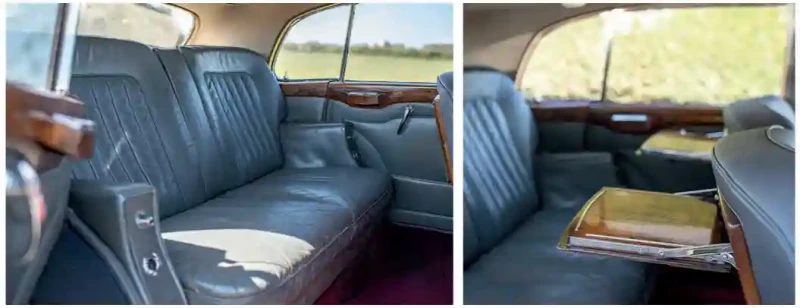
A fast car in its day, the old lady can still pick up her skirts. 4257cc engine in standard, healthy form. An easier route in and out for rear seat passengers than in Standard Steel saloon Picnic tables are large and useful. Falling coachline at waist height echoes wing and window line Clap-hands door opening is not pillarless, but still gives good access. Split windscreen a rare old-fashioned touch on this design.
Clap-hands door opening is not pillarless, but still gives good access.
This model's best angle? Rear three-quarter is very graceful Large wheel makes it easy to place this sizeable car accurately on the road Worn pedal rubbers speak off plenty of enjoyable use Main dash veneer has a dramatic grain pattern Note two armrests per seat — almost throne like.
MULLINER’S MISSION TO MODERNISE
In an article written for the RREC Bulletin No 161, Arthur Talbot Johnstone, formerly a managing director of H J Mulliner, mentioned a perceived need by 1948 for modernised coachbuilding methods. It seems they knew Rolls-Royce were interested in producing a high-performance Bentley based on the pre-war Corniche, which of course became the R-type Continental, and which demanded a weight saving. Before that car took shape, Johnstone accompanied Mulliner’s technical director Stanley Watts to Italy to visit Farina, Ghia and Bertone. They were impressed by Touring in Milan and considered licensing their Superleggera system of a steel tube frame with aluminium panels.

Instead, Watts and Johnstone decided a further improvement could be made by using aluminium for the supporting frame as well. They consulted British Aluminium who offered extrusions of an aluminium alloy called Reynolds Metal in various cross-sections, which led to the construction of three prototypes. These were what Johnstone described as a ‘special two-door, sloping back design’, given number 7210, one of which (B9EW) is pictured above. The Autocar’s Motor Show report of 7th October 1949 describes this car as being framed in T-section aluminium with 16-gauge skin, weighing 350lb (159kg) less than the steel equivalent – presumably the standard saloon. Later in the Bulletin piece, Johnstone writes: “This method of construction was then more generally adopted by H. J. Mulliner on models built from about 1952 onwards, being known as the ` lightweight' bodies. So H.J. Mulliner’s new six-light, four-door saloon took a significant step forward not only in style, but in structure. This was design 7243, marketed as the ‘Lightweight’ saloon and exhibited only a year after the coupé, at the 1950 Motor Show. Customer deliveries began in 1951. We’re indebted to Tom Clarke for the photos and line drawing reproduced here; the car is the first Lightweight, ch B355GT, and the drawing is Mulliner’s plan view and side elevation with the layout for the Smith’s heating and ventilation system.
